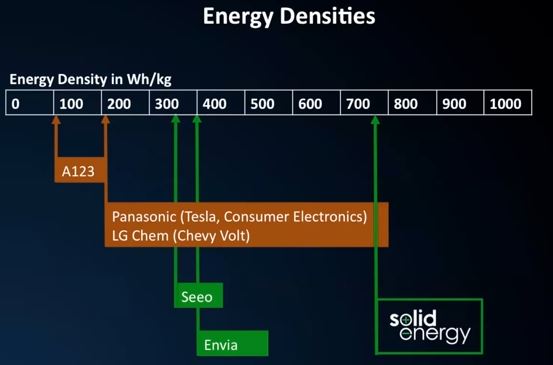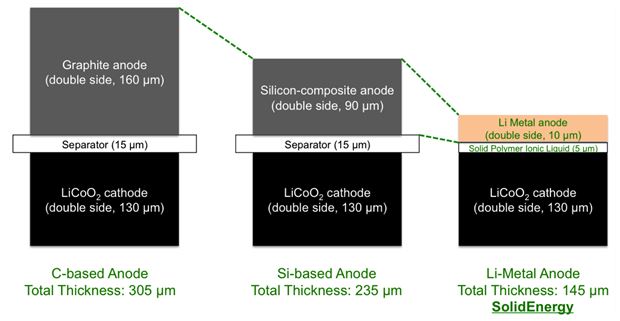More Energy, Smaller Package
SolidEnergy, a company spawned from the research labs at MIT, has produced and patented a rechargeable battery that could make conventional Li-ion batteries a thing of the past. That’s good news for laptop, tablet, and smartphone users, and even better news for the electric vehicle market.
Go Farther on a Full Charge
Conventional Li-ion batteries can store about 200 watt-hours per kilogram (Wh/kg) of mass. SolidEnergy claims that their technology - the Solid Polymer ionic liquid (SPIL) battery - can theoretically pack almost four times that energy for the same amount of mass. What does that mean in terms of electric vehicle range? The BMW i3 EV has a 22 kWh Li-ion battery bank. On a full charge, the i3 can travel about 200 km (125 miles). Replace the Li-ion batteries with SPIL batteries and that range increases to 750 km (466 miles).

Cooler and Safer

The image above compares other Li-ion batteries with the SolidEnergy battery. The SPIL electrolyte is thinner than a standard separator, decreasing the overall size and weight. When combined with the lithium metal anode, the blend not only increases energy density but also improves the number of recharge cycles. Even better, the combination prevents dendrite growth, a significant cause of Li-ion battery failures, and allows the batteries to operate at temperatures as high as 250oC, a temperature that would cause conventional Li-ion batteries to explode.
New Technology, Same Manufacturing Process
We’re all familiar with inertia, an object’s natural resistance to changes in motion. Newton’s First Law also applies to human and corporate behavior. Fortunately a complete retooling of battery factories won’t be required in order to change from standard Li-ion batteries to SPIL batteries. They use the same cathode material and the same manufacturing processes, so the change should be simple and inexpensive.
Starting Small
For now, SolidEnergy is working on batteries for low-power devices like portable electronics. They’ve produced a prototype battery that has twice the energy density of batteries found in today’s tablets and cell phones, and expect that model to be commercially available in 2016. After gaining a foothold in that market, they’ll be setting their sites on the electric vehicle industry. Should be an interesting ride!
